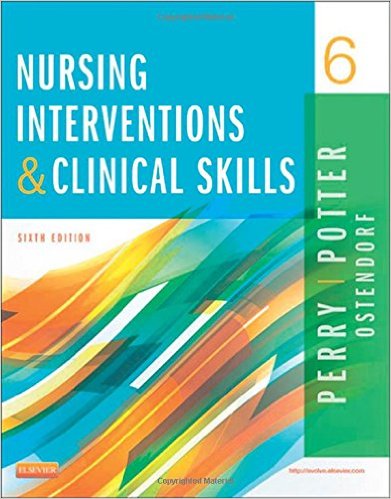Test Bank For Nursing Interventions & Clinical Skills, 6th Edition- by Anne Griffin Perry – Potter – Ostendorf
Chapter 04: Patient Safety and Quality Improvement
Perry et al.: Nursing Interventions & Clinical Skills, 6th Edition
MULTIPLE CHOICE
1. The nurse is caring for a 79-year-old male who has a non–weight-bearing cast on the left lower extremity. The patient ambulates without using a walker despite repeated instruction from the nurse to call for assistance. Which response by the nurse is most likely to keep the patient from falling?
a.
Apply a vest restraint and offer frequent toileting.
b.
Plan fall prevention with patient, family, and healthcare provider.
c.
Inform family that the patient needs physical restraints.
d.
Document that the patient has a high potential for falling.
ANS: B
Planning an individualized fall prevention program with the help of the patient, family, and healthcare provider is more likely to reduce the patient’s risk of falls because he gains some control over the plan of care and still benefits from the input of the provider, family, and nurse and the fall prevention program. A combination of interventions is more useful in preventing falls. Including the patient in planning also gives him ownership of the plan, making it less likely that he will disregard a plan he helped to design. Vest restraints are associated with serious injuries and are not recommended for use. Documenting the patient’s risk is important because it communicates the information and records the nurse’s acknowledgment of the risk, but it is not as effective as engaging the patient in planning care as a prevention technique because it is indirect. Alternative methods of engaging the patient in a care plan that minimizes risks should be exhausted before resorting to restraints.
DIF:Cognitive Level: AnalyzeREF:Page 48-49
OBJ: NCLEX: Safe and Effective Care TOP: Nursing Process: Implementation
2. The nurse plans a fall prevention program for a confused patient. Which task from the program is suitable for the nurse to delegate to nursing assistive personnel (NAP)?
a.
Evaluating patient understanding of fall prevention plan
b.
Keeping the patient’s bed in the low position at all times
c.
Assessing the patient’s circulatory and respiratory status
d.
Instructing the patient’s family about alternatives to restraints
ANS: B
The nurse may delegate keeping the bed lowered to the NAP because the NAP is trained to perform the task with proper nursing supervision. Skills used to prevent falls can often be delegated. The nurse does not delegate the remaining options because they involve aspects of the nursing process that require the advanced training of a nurse to perform.
DIF:Cognitive Level: ApplyREF:Page 49
OBJ: NCLEX: Safe and Effective Care TOP: Nursing Process: Planning
3. The nurse plans care for a patient who requires physical restraint. Which is a suitable goal for this patient?
a.
The patient remains free of any injury.
b.
The nurse checks the restraint every hour.
c.
The nurse uses the least restrictive restraint.
d.
The patient allows the nurse to apply restraints.
ANS: A
When restraints become necessary, the patient must remain free of injury; thus the nurse plans frequent neurovascular checks and removes the restraint on a regular basis to inspect the skin for pressure points and breakdown and perform range-of-motion exercises to maintain joint flexibility. Checking the restraint is a nursing intervention; it is not a goal because it is not patient centered. Using the least restrictive restraint can defeat the purpose of a restraint. When a restraint is required, the nurse uses the proper restraint to keep the patient safe and facilitate the therapeutic regimen. This is not a suitable goal because it focuses on the nurse. If the patient or staff members’ safety is at risk, the nurse applies restraints without the patient’s permission.
DIF:Cognitive Level: UnderstandREF:Page 58-60
OBJ: NCLEX: Safe and Effective Care TOP: Nursing Process: Planning
4. The nurse applies a physical restraint to the patient. Which entry should the nurse make after applying physical restraints?
a.
Performed restraint application reluctantly
b.
Applied bilateral soft lamb’s wool wrist restraints; skin pink, moist, and intact
c.
Will perform a neurovascular assessment every 4 hours
d.
Checked provider’s prescription for prn restraints
ANS: B
The nurse documents the type of restraint applied and the condition of the skin where the restraint was placed in the progress notes to communicate the information to the healthcare team. The nurse does not document subjective statements about the nurse. Neurovascular assessments of a patient’s extremity must take place at least every 2 hours because skin breakdown can occur very quickly. The nurse does not accept prn prescriptions for restraints according to nursing standards and federal regulations.
DIF:Cognitive Level: ApplyREF:Page 63
OBJ: NCLEX: Safe and Effective Care TOP: Nursing Process: Apply
5. The patient sustains a minor leg abrasion and stops breathing for a few seconds during a grand mal seizure. Which is the best nursing documentation after the patient’s seizure?
a.
Type of muscle contractions
b.
Size and description of the abrasion
c.
Length of the patient’s apneic episode
d.
Description of the seizure in detail
ANS: D
Describing the seizure in detail is the best documentation after a seizure because it is the most comprehensive item listed and includes the type of muscle contractions observed during the seizure, the description of injuries, how the injuries occurred, and the description of any breathing abnormalities.
DIF:Cognitive Level: AnalyzeREF:Page 67
OBJ: NCLEX: Safe and Effective Care TOP: Nursing Process: Implementation
6. A patient at risk for falling is being ambulated. Which action by the nurse is most important to prevent the patient from falling?
a.
Raising the bed to an appropriate working height
b.
Placing nonskid shoes on the patient
c.
Dangling the patient on the side of the bed for 10 minutes
d.
Turning on the brightest lights in the room
ANS: B
Placing nonskid surfaces on the patient’s feet helps to prevent falls. The height of the bed should be as low as possible before attempting to have the patient stand. Dangling prevents dizziness, but the length of time differs, and it is not required for all patients. Adequate light is important, but the brightest lights are not needed.
DIF:Cognitive Level: ApplyREF:Page 50
OBJ: NCLEX: Safe and Effective Care TOP: Nursing Process: Planning
7. The nurse is orienting a group of new nurses and explaining the concept of sentinel events and their causes. What should the nurse explain as the number one root cause of all sentinel event reports to The Joint Commission?
a.
Medication errors
b.
Falls
c.
Communication failures
d.
High patient-to-nurse ratios
ANS: C
Communication failures are the number one root cause of all sentinel events reported to The Joint Commission. A sentinel event is an unexpected occurrence involving death, serious physical or psychological injury, or risk thereof. Although the other elements may cause sentinel events, they are not the number one root cause.
DIF:Cognitive Level: RememberREF:Page 46
OBJ: NCLEX: Safe and Effective Care TOP: Nursing Process: Planning









Reviews
There are no reviews yet.